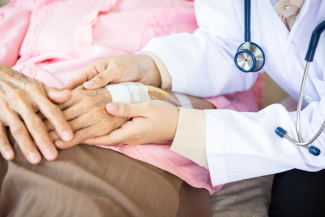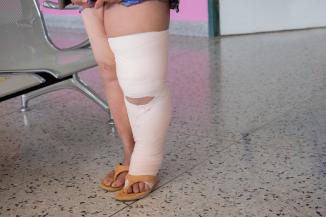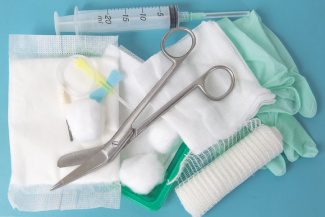Moving Nursing Forward After the NPUAP Pressure Injury Staging Changes
July 21, 2016
I was not at the April National Pressure Ulcer Advisory Panel (NPUAP) meeting, but I do think some of critical commentary that has followed the announcement of the pressure injury staging system changes is flawed. Clearly designating the thickness of an injury to a defined wound stage makes sense and communicates a severity. All the NPUAP have done is clarify some detail that clinicians have had to manage previously, within a gray area. It is not the responsibility of the NPUAP, researchers or clinicians at the bedside to make up definitions to fit coding or legislators. It is important that researchers and bedside clinicians provide the Centers for Medicare & Medicaid Services (CMS) and legislators with research demonstrating how and why pressure ulcers occur.
Taking Responsibility for Pressure Injuries
I have seen pressure ulcers from negligence and ignorance throughout my career and the current belief within the profession that many are not preventable needs proof. From ICU nurses wanting to blame not being able to turn patients because of their unstable condition, to floor nurses stating patient's refusal and non-compliance, such excuses are often (but I accept not always) exactly that: excuses. It is time to 'fold' and accept that we need to take responsibility. We have given away nursing care to under-trained, under-paid and under-valued non-professionals. There is little direction or communication and even less oversight of the nursing assistant role. Nurses work from protocols and orders with little regard for planning care and individualizing care plans.
Care planning is a paper exercise to keep Joint Commission happy, but no one uses them. There are orders for everything from allowing the patient to get on to a commode, to ensuring they have offloading boots (left on the windowsill). Orders such as Q 2 hour turns gets transcribed into the chart and are either ignored or just worked around to fit into the routines that usually work for most patients.Our art has died, we are painting by numbers and it is visible to all who give more than a cursory glance to nursing care.
An Opportunity to Improve Pressure Injury Prevention
How can we go forward into the future rather than looking to the past as perfect? (Which, of course it never was.) In terms of pressure ulcers, there is no doubt that from the moment CMS stopped paying for hospital-acquired pressure injuries there was motivation from health care administration to prevent them. It gave nursing the opportunity to improve care, but with fewer resources and such an unmotivated bedside workforce, there was little hope of achievement. It is now time to use what we know to get what we need.
We know that in order to prevent pressure ulcers, offloading and the optimum pressure redistribution surface is important1. We know that optimal skin care will make the skin more resilient2. We know that dependent patients develop pressure injuries more than those who are able to mobilize and that regular repositioning with an individual schedule for patients prevents pressure injuries3. Exactly how positioning can optimize offloading and gain patient cooperation is very important (particularly in the rehab setting). Paying attention to detail and straightening sheets, moving and repositioning devices is often underplayed4. The way we handle patients has a role to play, as does the equipment we use. Having people at the bedside to actually perform all the necessary, detailed care is imperative. But where are the people at the bedside? Who trains them and what value do we give them?
The role patients and relatives play in preventing pressure injuries, and how they are educated and introduced to the alien concept of skin breakdown is much more important than many realize (therein lies a research project). So maybe the NPUAP did not do what many had hoped or even the right thing, but let us take care not to throw out the baby with the bathwater. What we have is usable and can be developed further as we progress with research. For now, we have work to do so that nursing can move forward without being pushed by CMS or ordered by doctors.
References
1. McNichol L, Watts C, Mackey D, Beitz JM, Gray M. Identifying the Right Surface for the Right Patient at the Right Time: Generation and Content Validation of an Algorithm for Support Surface Selection. J Wound Ostomy Continence Nurs. 2015 Jan-Feb;42(1):19-37. doi: 10.1097/WON.0000000000000103.
2. Ayello EA, and Sibbald RG. Preventing pressure ulcers and skin tears. In Bolz M, Capezuti E, Fulmer T, Zwicker D, (Editors). Evidenced based Nursing protocols for best practice. 4th ed New York (NY) Springer pub co 2012 298-324.
3. Moore Z, Cowman S, Conroy RM. A randomised controlled clinical trial of repositioning, using the 30° tilt, for the prevention of pressure ulcers. J Clin Nurs. 2011 Sep;20(17-8):2633-44. doi: 10.1111/j.1365-2702.2011.03736.x. Epub 2011 Jun 27.
4. Pittman J, Beeson T, Kitterman J, Lancaster S, Shelly A. Medical device-related hospital-acquired pressure ulcers: development of an evidence-based position statement. J Wound Ostomy Continence Nurs. 2015 Mar-Apr;42(2):151-4.
About The Author
Margaret Heale has a clinical consulting service, Heale Wound Care in Southeastern Vermont and draws on her extensive experience as a wound, ostomy and continence nurse in acute and long-term care settings to provide education and holistic care in her practice.
The views and opinions expressed in this content are solely those of the contributor, and do not represent the views of WoundSource, HMP Global, its affiliates, or subsidiary companies.










